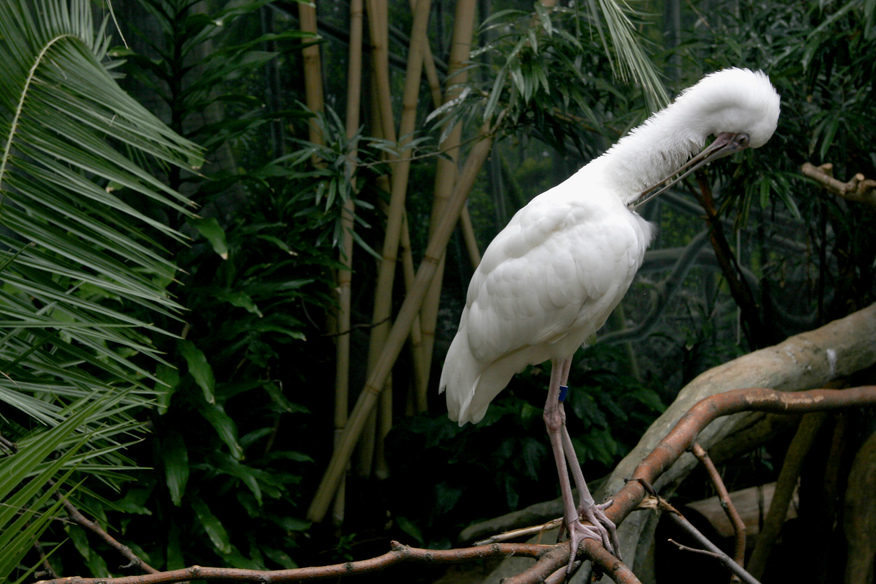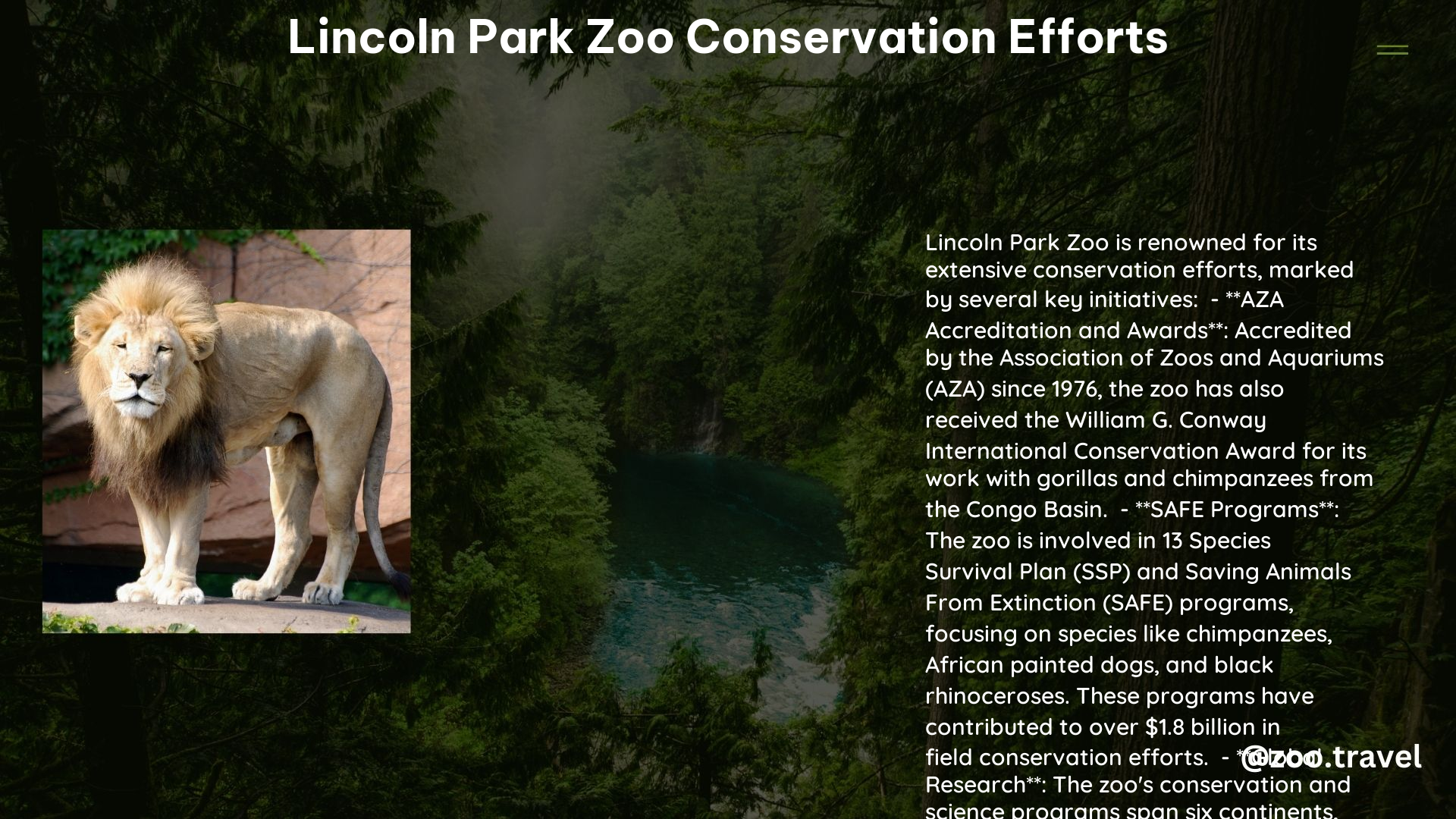Lincoln Park Zoo, located in Chicago, Illinois, is at the forefront of wildlife conservation. The zoo’s efforts span global initiatives, species recovery programs, habitat restoration, and educational outreach. With a focus on scientific research and collaboration, Lincoln Park Zoo contributes significantly to protecting endangered species and their habitats across six continents. Their work includes monitoring wildlife populations, reducing human-wildlife conflicts, and participating in crucial breeding programs to ensure the survival of threatened species.
What Are the Key Conservation Programs at Lincoln Park Zoo?

Lincoln Park Zoo’s conservation efforts are diverse and far-reaching. Here are some of the key programs:
- Global Conservation Programs
- Species Recovery Programs
- Habitat Restoration Projects
- Conservation Education Initiatives
- Research Partnerships
Let’s delve deeper into each of these programs to understand their impact and significance.
How Does Lincoln Park Zoo Contribute to Global Conservation?

Lincoln Park Zoo’s global conservation efforts are truly impressive in their scope and impact:
- Tanzania Conservation Research Program (TCRP): Active since 1995, this program focuses on:
- Monitoring wildlife populations
- Protecting wildlife from disease transmission
-
Reducing human-wildlife conflict in northern Tanzania
-
Six-Continent Reach: The zoo’s conservation efforts span across:
- Africa
- Asia
- Europe
- North America
- South America
-
Australia
-
Wildlife Migration Corridors: The zoo works to protect critical pathways for animal movement, essential for maintaining healthy wildlife populations.
What Species Recovery Programs Does Lincoln Park Zoo Participate In?
Lincoln Park Zoo is deeply involved in species recovery programs, playing a crucial role in protecting endangered species:
- Association of Zoos and Aquariums (AZA) Species Survival Plan (SSP):
- Participation in 89 SSPs
- Focus on maintaining sustainable zoo populations
-
Supporting conservation efforts in the wild
-
Saving Animals From Extinction (SAFE) Programs:
- Involvement in 13 SAFE programs
- Leveraging collective expertise of AZA-accredited institutions
- Recovery efforts for species like red wolves and black-footed ferrets
| SAFE Program Species |
|---|
| Chimpanzees |
| North American Songbirds |
| African Painted Dogs |
| North American Monarch Butterflies |
| African Vultures |
| American Red Wolves |
| American Turtles |
| Sharks and Rays |
| Gorillas |
| African Penguins |
| Black Rhinoceroses |
| Giraffes |
| African Lions |
How Does Lincoln Park Zoo Contribute to Habitat Restoration?
Habitat restoration is a crucial aspect of Lincoln Park Zoo’s conservation efforts:
-
Wildlife Migration Corridors: The TCRP in Tanzania focuses on protecting these vital pathways, ensuring the free movement of wildlife populations.
-
Habitat Studies: The zoo conducts research on how wildlife uses various habitats:
- Urban environments
- Savannas in Africa
- Forests in Africa
These studies inform better conservation strategies and help in developing more effective habitat restoration projects.
What Conservation Education Initiatives Does Lincoln Park Zoo Offer?
Education plays a pivotal role in Lincoln Park Zoo’s conservation efforts:
- Science and Conservation Programs: While specific metrics aren’t available, the zoo offers various programs aimed at:
- Raising public awareness
-
Engaging the community in conservation efforts
-
AZA Involvement: Zoo staff actively participate in AZA activities:
- Running committees
- Leading workshops
- Presenting papers
These activities contribute to educational outreach and capacity building within the conservation community.
How Does Lincoln Park Zoo Collaborate with Other Organizations for Conservation?
Lincoln Park Zoo’s conservation efforts are strengthened through numerous partnerships and collaborations:
- Global Partnerships: The zoo collaborates with:
- Universities
- NGOs
- Government agencies
-
Other zoos and aquariums worldwide
-
Long-term Collaborations:
- Conservation partners in Tanzania since 2005
-
Involvement in the Goualougo Triangle Ape Project
-
Research Centers: The zoo hosts several research centers:
- Population Management Center
- Alexander Center for Applied Population Biology
These centers support various conservation activities, including:
– Wildlife reintroduction programs
– Demographic data analysis
What Are the Financial Investments and Metrics of Lincoln Park Zoo’s Conservation Efforts?
The financial commitment and scientific output of Lincoln Park Zoo’s conservation efforts are substantial:
- Financial Investments:
- AZA institutions, including Lincoln Park Zoo, have invested over $1.8 billion in field conservation efforts.
-
These investments benefit animals and their habitats globally.
-
Scientific Output:
- The zoo’s scientific team has produced over 1,000 scientific articles and book chapters since 1989.
- This impressive output reflects the depth and breadth of their research and conservation efforts.
How Does Lincoln Park Zoo’s Conservation Work Impact Specific Species?
Lincoln Park Zoo’s conservation efforts have a significant impact on various species:
-
Chimpanzees: The zoo participates in SAFE programs focused on chimpanzee conservation, contributing to both captive breeding and wild population protection.
-
African Painted Dogs: Through SAFE programs, the zoo works to protect this endangered species, focusing on habitat preservation and anti-poaching efforts.
-
Black Rhinoceroses: The zoo’s involvement in SAFE programs for black rhinoceroses contributes to the protection of this critically endangered species.
-
Gorillas: Lincoln Park Zoo’s conservation efforts extend to gorillas, participating in breeding programs and supporting field conservation initiatives.
-
African Vultures: The zoo’s SAFE program for African vultures helps protect these important scavengers, crucial for ecosystem health.
What Unique Conservation Approaches Does Lincoln Park Zoo Employ?
Lincoln Park Zoo employs several unique approaches in its conservation efforts:
-
Urban Wildlife Institute: This initiative studies wildlife in urban environments, providing valuable insights into human-wildlife coexistence.
-
Population Management Center: This center helps manage captive populations of endangered species across multiple institutions, ensuring genetic diversity.
-
One Health Approach: The zoo integrates human, animal, and environmental health in its conservation strategies, recognizing the interconnectedness of these factors.
-
Community-Based Conservation: In projects like the TCRP, the zoo works closely with local communities to develop sustainable conservation practices.
-
Technology in Conservation: The zoo utilizes advanced technologies like GPS tracking and remote sensing in its research and monitoring efforts.
How Does Lincoln Park Zoo Measure the Success of Its Conservation Efforts?
Measuring conservation success is crucial for Lincoln Park Zoo:
-
Population Monitoring: The zoo tracks population trends of species in their natural habitats, particularly in long-term projects like the TCRP.
-
Breeding Success: For captive breeding programs, success is measured by the number of successful births and the genetic diversity maintained in the population.
-
Scientific Publications: The quantity and impact of research publications serve as a metric for the zoo’s contribution to conservation science.
-
Habitat Protection: Success is measured by the amount of critical habitat protected or restored through the zoo’s efforts.
-
Community Engagement: The zoo evaluates the success of its education and outreach programs through community participation and attitude changes towards conservation.
Lincoln Park Zoo’s conservation efforts represent a comprehensive approach to wildlife protection and habitat preservation. Through global programs, species recovery initiatives, habitat restoration, education, and research partnerships, the zoo makes significant contributions to biodiversity conservation. Their work not only helps protect endangered species but also advances our understanding of wildlife ecology and conservation science. As the zoo continues to innovate and collaborate, its impact on global conservation efforts is likely to grow, offering hope for the future of our planet’s diverse ecosystems and the species that inhabit them.
References:
– https://www.lpzoo.org/conservation-science/science-centers/tanzania-conservation-research-program/
– https://www.lpzoo.org/conservation-science/
– https://www.lpzoo.org/saving-species-with-safe/
